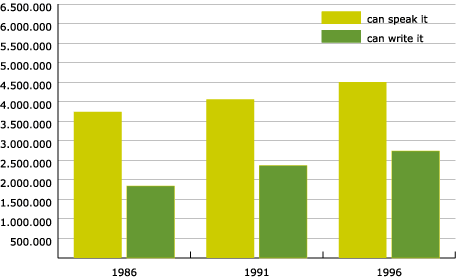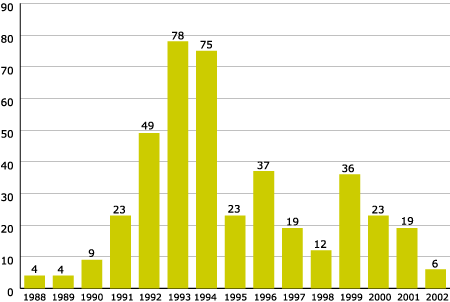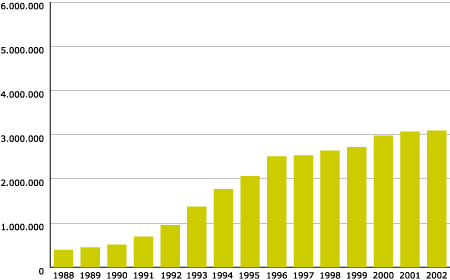
Summer 2003 |
| The System of Linguistic Indicators (SIL): purpose and general features, by Joan Solé Camardons | ||||
This article defines the concept of linguistic indicator and formulates the central features of the System of Linguistic Indicators (SIL), in consultation with a group of experts. This System has been developed by the Institute of Catalan Sociolinguistics (ISC) of the Directorate General for Language Policy (DGPL), and limited examples of indicators in the languages of Catalonia are given.
|
|||
Summary 1. What is a linguistic indicator? 2. Precedents and types of indicators in Catalonia 3. What is the system of linguistic indicators? 4. The basis for the system of linguistic indicators 5. Recommendations of the SIL commission 7. Basic bibliography on social and linguistic indicators 1. What is a linguistic indicator? The term cultural indicator was introduced in 1969 by G. Gerbner, a researcher at the University of Pennsylvania to assist in understanding the effect of the media on culture. In the mid seventies, UNESCO began the study of cultural indicators. Here, we define linguistic indicator (1) as a serial variable or relationship between quantitative-type variables, whose measurement over a period of time will provide relevant information on the linguistic situation of an organisation, of its environment or of society in general, and assist in the taking of policy and technical decisions in language planning. The indicators have the following features, among others: a) Clarity of definition: the concepts that are utilised have to be explicitly stated, without any ambiguity or confusion. b) Relevance of formulated objectives: the latter have to be explicitly related to the working hypotheses of our approach to our work . c) Relevance of variables: variables in question have to measure the most relevant aspects of what we want. d) Feasibility: it has to be possible to collect the data by means which are at our disposal or which can be put at our disposal. The timetable and the place of data collection also have to be agreed upon, among other aspects. e) Stability: the data indicators have to constitute a series over time. The indicators have to be arrived at by consensus, but once adopted cannot be submitted to discussion. f) Reliability: they have to be reliable, such that any change in the indicator will correspond to a change in the variable which is measured. g) Comprehensiveness: they have to be comprehensive but not specialised, although the techniques involved in processing them may be complex. 2. Precedents and types of linguistic indicators in Catalonia Among the different projects and tools involving linguistic indicators which have been developed in Catalonia, we would particularly mention the following: a) The data on knowledge of Catalan provided by the censuses and voting lists (2) have been the first and often the most relevant of the linguistic indicators. (3). (Noves SL, Autumn 2000) b) A second point of reference, initially, was the Index of Linguistic Normalisation in Catalonia (ILNIC), (4) a planned project, not carried out. A presentation on the project was given at the II International Conference on Catalan Language in 1986. c) Between 1993 and 1997, the project on the Index of Use of Catalan (INUSCAT) (5) measuring the state of the language by means of an objective indicator and a subjective indicator. d) From 1995 onward a tool was developed and piloted throughout the territory: Indexplà (6).The latter had a double purpose, as a battery of micro-indicators of the Catalan language in any given organisation, and as a tool of the programme of language normalisation developed especially at the Consortium for Language Normalisation. e) The indicators (7) of the General Language Normalisation Plan, directly related to the key results (8) of the Plan in various sectors. f) Ofercat, facility which measures the presence or provision of the Catalan language in a given organisation. All these projects and tools provided the theoretical and practical basis for much of the present project, which we shall refer to, from now on, as the System of Linguistic Indicators (SLI). 3. What is the System of Linguistic Indicators? From 1998 onward, in accordance with the normative framework, (9) the DGPL embarked on a project known as the System of Linguistic Indicators (SLI) with a double purpose in mind: a) To collect and process the data on knowledge, provision and use of the Catalan language by general population and by specific sectors. b) Collect and process the data relating to the results, in terms of sociolinguistic impact, of action taken by Language Policy. This project sets out to systematise a multiplicity of data from different information sources and multiple collection methods: linguistic census, official and non-official questionnaires, observation, Indexplà, Ofercat and other projects and studies in series. On the other hand, it should also be remembered that since 1998 the DGPL has been regularly compiling the Informe de Política Lingüística (Language Policy Report) which is presented to the Catalan Parliament and the Catalan Language Social Council. While it is true that a part of the data contained in the Report are indicators, the SLI project, as we have seen, is intended for a different purpose and complements the Report. In 2001, a database of linguistic indicators with three dimensions: situation (knowledge, supply and language use), activity (language policies) and impact (result of these policies). The situation measures the conditions in which those in receipt of the actions and the environment in which they take place(percentage of population who speak Catalan, the percentage of use of Catalan in the municipal documentation, in the posters, in the signs, etc.). We see here an example of a situation indicator in graph 1. Graph 1.
Change over time in population
The activity dimension measures the volume of products and services (number of courses, students, agreements in force, number of local corporations who have approved legislation promoting Catalan). Below in graph 2 is an example of an activity indicator. Graph 2. Legislation supporting the use of Catalan, passed by local corporations
The impact measures the results achieved by the actions in favour of Catalan: number of inhabitants living in local government areas with legislation on the use of Catalan, percentage of personnel with sufficient knowledge, law courts and offices where Catalan can be used orally, number of transmitters that broadcast more than 50% in Catalan, etc. Graph 3 shows an example of an indicator of impact . Graph 3. Accumulated population of inhabitants with local legislation on the use of Catalan
This project comprises, therefore, of a system of indicators which have to be simultaneously available, and constitute indicators of the activity, impact and situation, supply and use of Catalan. In 2002 a commission of experts and language policy managers wrote the report on the System of Linguistic Indicators (SIL), centred principally on indicators of the Situation of the language and also the Impact. See appendix 1: provisional list of Linguistic Indicators. (PDF 34 KB). The commission consisted of some twenty experts with backgrounds in such diverse fields as: statistics, sociology, policy evaluation, sociolinguistics, psychology, language planning, law, education and other professional activities. This commission was headed by Lluís Jou and other members were: Josep Maria Aragay, Joaquim Arenas, Joaquim Capellades, Francesc Domínguez, Albert Fabà, Jaume Farràs, Yvonne Griley, Marc Leprêtre, Marta Masats, Josep Missé, Mònica Pereña, Miquel Pueyo, Enric Renau, Elvira Riera, Mercè Romagosa, Joan Maria Romaní, Marta Rovira, Mercè Solé, Joan Subirats, Albert Valero, Francesc Vallverdú, Àngels Viladot, Josep Maria Vilalta and Joan Solé Camardons who acted as coordinator. 4. Basis for the System of Linguistic Indicators These are the outcome of oral and written observations by the commission of experts in many different general and section meetings. The observations were reordered and put in context to facilitate their comprehension. |


